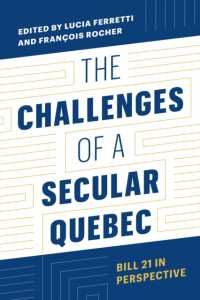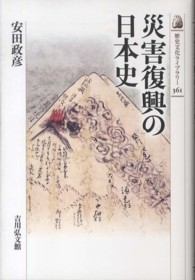- ホーム
- > 洋書
- > 英文書
- > Literary Criticism
Full Description
One of the best known and most widely read of early African American writers, Charles W. Chesnutt published more than fifty short stories, six novels, two plays, a biography of Frederick Douglass, and countless essays, poems, letters, journals, and speeches. Though he had light skin and was of mixed race, Chesnutt self-identified as a black man, and his writing was often boldly political, openly addressing problems of racial identity and injustice in the late 19th century.
This collection of critical essays reevaluates the Chesnutt legacy, introducing new scholarship reflective of the many facets of his fiction, especially his sophisticated narrative strategies.
Contents
Table of Contents
Introduction
MARIA ORBAN
1. Charles W. Chesnutt, Jack Thorne and the African American Literary Response to the 1898 Wilmington Race Riot
LINDA BELAU AND ED CAMERON
2. "The fruit of my own imagination": Charles W. Chesnutt's The Marrow of Tradition in the Age of Realism
WILLIE J. HARRELL, JR.
3. "I shall leave the realm of fiction": Conjure, Genre, and Passing in the Fiction of Charles W. Chesnutt
CHRISTOPHER BUNDRICK
4. "Those folks downstairs believe in ghosts": The Eradication of Folklore in the Novels of Charles W. Chesnutt
WILEY CASH
5. The Fiction of Race: Folklore to Classical Literature
MARIA ORBAN
6. Charles W. Chesnutt's The House Behind the Cedars: An Outlaw(ed) Reading
COLEMAN C. MYRON
7. Reading the Transgressive Body: Phenomenology in the Stories of Charles W. Chesnutt
KIM KIRKPATRICK
8. "Your people will never rise in the world": Chesnutt's Message to a Black Readership
TYRIE J. SMITH
9. Vanished Past and Vanishing Point: Charles W. Chesnutt's Short Stories and the Problem of American Historical Memory
ZOE TRODD
10. All Green with Epic Potential: Chesnutt Goes to the Marrow of Tradition to Re-Construct America's Epic Body
GREGORY E. RUTLEDGE
11. "The Wife of His Youth": A Trickster Tale
CYNTHIA WACHTELL
12. With Myriad Subtleties: Recognizing an Africanist Presence in Charles W. Chesnutt's The Conjure Woman
TIEL LUNDY
13. Passing for What? The Marrow of Tradition's Minstrel Critique of the Unlawfulness of
JULIE IROMUANYA
14. Geographies of Freedom: Race, Mobility, and Uplift in Charles W. Chesnutt's Northern Writing
MICHELLE TAYLOR
15. Motherhood, Martyrdom and Cultural Dichotomy in Charles W. Chesnutt's The House Behind the Cedars
B. OMEGA MOORE
Epilogue: The Gifts of Ambiguity
MICHELLE TAYLOR
About the Contributors
Index







